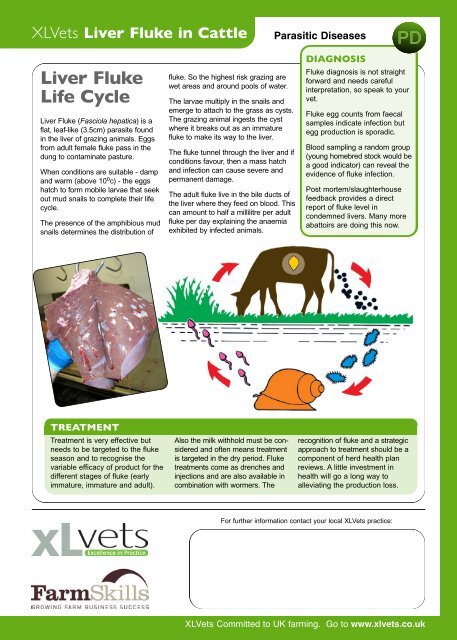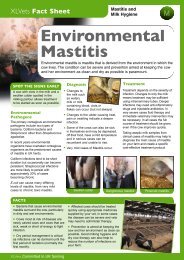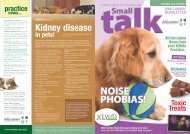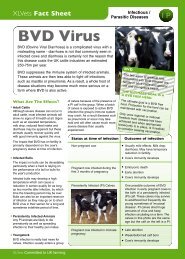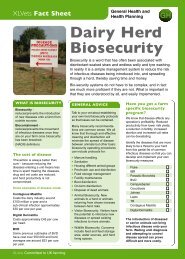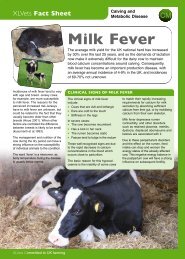Liver Fluke in Cattle - Cheviot Futures
Liver Fluke in Cattle - Cheviot Futures
Liver Fluke in Cattle - Cheviot Futures
You also want an ePaper? Increase the reach of your titles
YUMPU automatically turns print PDFs into web optimized ePapers that Google loves.
XLVets <strong>Liver</strong> <strong>Fluke</strong> <strong>in</strong> <strong>Cattle</strong><br />
<strong>Liver</strong> <strong>Fluke</strong><br />
Life Cycle<br />
<strong>Liver</strong> <strong>Fluke</strong> (Fasciola hepatica) is a<br />
flat, leaf-like (3.5cm) parasite found<br />
<strong>in</strong> the liver of graz<strong>in</strong>g animals. Eggs<br />
from adult female fluke pass <strong>in</strong> the<br />
dung to contam<strong>in</strong>ate pasture.<br />
When conditions are suitable - damp<br />
and warm (above 10 o c) - the eggs<br />
hatch to form mobile larvae that seek<br />
out mud snails to complete their life<br />
cycle.<br />
The presence of the amphibious mud<br />
snails determ<strong>in</strong>es the distribution of<br />
fluke. So the highest risk graz<strong>in</strong>g are<br />
wet areas and around pools of water.<br />
The larvae multiply <strong>in</strong> the snails and<br />
emerge to attach to the grass as cysts.<br />
The graz<strong>in</strong>g animal <strong>in</strong>gests the cyst<br />
where it breaks out as an immature<br />
fluke to make its way to the liver.<br />
The fluke tunnel through the liver and if<br />
conditions favour, then a mass hatch<br />
and <strong>in</strong>fection can cause severe and<br />
permanent damage.<br />
The adult fluke live <strong>in</strong> the bile ducts of<br />
the liver where they feed on blood. This<br />
can amount to half a millilitre per adult<br />
fluke per day expla<strong>in</strong><strong>in</strong>g the anaemia<br />
exhibited by <strong>in</strong>fected animals.<br />
Parasitic Diseases<br />
DIAGNOSIS<br />
<strong>Fluke</strong> diagnosis is not straight<br />
forward and needs careful<br />
<strong>in</strong>terpretation, so speak to your<br />
vet.<br />
<strong>Fluke</strong> egg counts from faecal<br />
samples <strong>in</strong>dicate <strong>in</strong>fection but<br />
egg production is sporadic.<br />
Blood sampl<strong>in</strong>g a random group<br />
(young homebred stock would be<br />
a good <strong>in</strong>dicator) can reveal the<br />
evidence of fluke <strong>in</strong>fection.<br />
Post mortem/slaughterhouse<br />
feedback provides a direct<br />
report of fluke level <strong>in</strong><br />
condemned livers. Many more<br />
abattoirs are do<strong>in</strong>g this now.<br />
PD<br />
TREATMENT<br />
Treatment is very effective but<br />
needs to be targeted to the fluke<br />
season and to recognise the<br />
variable efficacy of product for the<br />
different stages of fluke (early<br />
immature, immature and adult).<br />
Also the milk withhold must be considered<br />
and often means treatment<br />
is targeted <strong>in</strong> the dry period. <strong>Fluke</strong><br />
treatments come as drenches and<br />
<strong>in</strong>jections and are also available <strong>in</strong><br />
comb<strong>in</strong>ation with wormers. The<br />
recognition of fluke and a strategic<br />
approach to treatment should be a<br />
component of herd health plan<br />
reviews. A little <strong>in</strong>vestment <strong>in</strong><br />
health will go a long way to<br />
alleviat<strong>in</strong>g the production loss.<br />
For further <strong>in</strong>formation contact your local XLVets practice:<br />
XLVets Committed to UK farm<strong>in</strong>g. Go to www.xlvets.co.uk


